Egon Eiermann
Egon Eiermann (29 September 1904 – 20 July 1970[1]) was one of Germany's most prominent architects in the second half of the 20th century. He was also a furniture designer. From 1947, he was Professor for architecture at the Technical University of Karlsruhe.
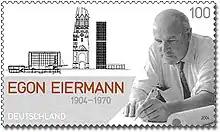
Biography
Eiermann was born in Neuendorf bei Potsdam (now part of Babelsberg, Potsdam), the son of Wilhelm Eiermann (1874–1948), a locomotive engineer and his wife Emma Gellhorn (1875–1959).[2][3] He archived his Abitur at the Althoff-Gymnasium[3] and studied architecture at the Technical University of Berlin.[1] From 1925 to 1928, he was master student of Hans Poelzig.[4] After graduating in 1928, he gained professional experience in the construction departments of Karstadt AG in Hamburg and the Berlin electricity works (Bewag (Berlin)).[3] From 1931 to 1945, he was an independent architect in Berlin and initially planned residential buildings.[2][5] Before World War II he had an office with fellow architect Fritz Jaenecke. During the Nazi era, he mainly created industrial architecture.[6] In 1945, he escaped to Buchen in West Germany, the birthplace of the father.[7] From 1946 to 1965, he had a shared office with Robert Hilgers.[2] In 1948, the office was relocated to Karlsruhe.[3] He joined the faculty of the Technische Hochschule Karlsruhe in 1947,[4][8] working there on developing steel frame construction methods. Students were Oswald Mathias Ungers and Julia Bolles-Wilson.[9][10][11] During a study trip to the United States in 1950, he met Walter Gropius, Marcel Breuer and Konrad Wachsmann in Boston, and in 1956 also Ludwig Mies van der Rohe.[2] In 1967, Eiermann chaired the jury in the architectural competition for the Olympic Park in Munich.[lower-alpha 1][13]
Personal life
In 1940, he married in Berlin interior designer Charlotte, née Friedheim (1912–2001) and in 1954 in Berlin architect Brigitte, née Feyerabendt (1924–2019). He had two children: with his first wife Andreas (born 1942), from his second marriage Anna (born 1956).[3]
He died in Baden-Baden, aged 65.[14] He is buried at the Buchen Cemetery.[7]
Works
During the years of reconstruction, his steel-frame industrial buildings became exemplary.[5] The buildings are transparent, inviting, democratic, making order visible.[15]
A functionalist, his major works include: the textile mill at Blumberg (1951);[16] the West German pavilion at the Brussels World's Fair (with Sep Ruf, 1958);[lower-alpha 2][8] the Embassy of Germany, Washington, D.C. (1958–1964);[8] the highrise Langer Eugen for the German Parliament in Bonn (1965–1969); the IBM-Germany Headquarters in Stuttgart (1967–1972);[14] and, the Olivetti building in Frankfurt (1968–1972). By far his most famous work is the new church on the site of the Kaiser Wilhelm Memorial Church in Berlin (1959–1963).
The sets of the 1926 film The Pink Diamond were designed by Eiermann.[17][3]
Source:[2]
- 1929–1930 Substation of the Berliner Elektrizitätswerke AG, Berlin-Steglitz
- 1931–1933 Hesse residential building, Berlin-Lankwitz
- 1936–1937 Steingroever residential building, Berlin-Grunewald
- 1938 factory building and boiler house of the Degea-AG-Auergesellschaft, Berlin-Wedding
- 1938–1939 expansion and conversion of the Total-Werke Foerstner & Co, Apolda
- 1939–1941 factory buildings of Märkische Metallbau GmbH, Oranienburg
- 1948–1950 administration and factory building of Ciba AG, Wehr/Baden
- 1949–1950 handkerchief weaving mill/spinning mill, Blumberg/Black Forest
- 1950–1953 administration building of the United Silk Weaving Works, Krefeld
- 1951–1956 experimental power plant of the Technical University, Karlsruhe[18]
- 1953 St. Matthew Church, Pforzheim[19]
- 1953–1954 Burda Moden publishing house, Offenburg
- 1954–1961 residential building, Interbau, Hansaviertel, Berlin-Tiergarten
- 1955–1957 Volkshilfe administration building, Cologne
- 1956–1958 German Pavilion, World Exhibition in Brussels (with Sep Ruf, exterior planning by Walter Rossow)
- 1956–1960 administration building of Steinkohlebergwerke AG, Essen
- 1957–1963 Kaiser Wilhelm Memorial Church, Berlin-Charlottenburg[20][21][22]
- 1958–1961 Head office of Neckermann Versand KG, Frankfurt am Main
- 1958–1961 administration building of the steel structure Gustav Müller, Offenburg
- 1958–1964 Chancellery building of the German Embassy, Washington[23][24][25]
- 1959–1962 Eiermann house, Baden-Baden[26]
- 1961–1967 buildings for the DEA-Scholven GmbH refinery, Karlsruhe[27]
- 1965–1969 high-rise building for members of the German Bundestag, Bonn[28]
- 1967–1972 Administration and training center of Deutsche Olivetti, Frankfurt am Main,[29]
- 1967–1972 IBM headquarters, Stuttgart-Vaihingen (Eiermann-Campus)[30]
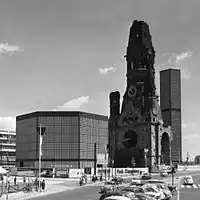
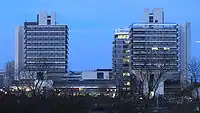

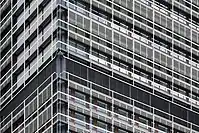 Langer Eugen, Bonn – detail of the facade[6]
Langer Eugen, Bonn – detail of the facade[6]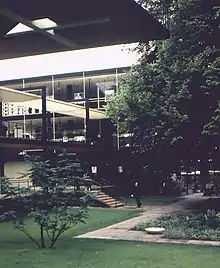
Design
From 1949, the first functional and serially produced seating furniture made of wood and tubular steel was created in cooperation with the Esslingen company Wilde + Spieth.[36]
- 1950 SE 68 tubular steel chair
- 1952 E 10 wicker chair
- 1952–1953 SE 18 wooden folding chair
- 1953 table frame Eiermann 1
- 1960–1961 Church seat SE 121
- 1965 table frame Eiermann 2
Awards
Source:[2]
- 1962 Berlin Art Prize
- 1965 honorary doctorate from the Technical University of Berlin
- 1965 Grand State Prize for Architecture of the State of North Rhine-Westphalia
- 1968 Grand Prize of the Association of German Architects (Großer BDA-Preis)
- 1968 Grand Federal Cross of Merit
- 1969 Hugo Häring Prize of the BDA Baden-Württemberg
- 1970 Order Pour le Mérite for Science and Arts
In 1997, the Egon Eiermann Society was founded in Karlsruhe.[38] In 2004, the Bundespost honored Eiermann with a special postage stamp.[3] In Karlsruhe, Egon-Eiermann-Allee (49°02′12″N 8°20′56″E) was named after him in 2009.[14] One of the lecture halls in the architectural building (49°00′40″N 8°24′40″E) of the Karlsruhe Institute of Technology bears his name.[39] The Egon Eiermann Award is an international ideas competition in architecture.[40]
Memberships
Source:[2]
- 1926 Founding member of the "Group of Young Architects" ("Gruppe junger Architekten")[41]
- 1931 Member of the Association of German Architects (Bund Deutscher Architekten)
- 1931 Member of Deutscher Werkbund[42]
- 1951 Founding member of the German Design Council (Rat für Formgebung)
- 1955 Member of the Academy of Arts, Berlin (West), Section Architecture
- 1960 Honorary member of the Central Association of Austrian Architects
- 1962 Member of the planning council for the new buildings of the German Bundestag and the German Bundesrat in Bonn
- 1963 Corresponding Honorary Member of the Royal Institute of British Architects
- 1969 Founding member of the Housing and Environment Institute of the Hessian state government
Notes
References
- "Egon Eiermann Tables and Chairs". Einrichten Design (in German). 29 September 1904. Retrieved 27 February 2022.
- "Eiermann". Akademie der Künste, Berlin (in German). Retrieved 27 February 2022.
- "Eiermann Egon Fritz". LEO-BW (in German). Retrieved 27 February 2022.
- Jouini, Saoussen (12 June 2021). "Architektur – Fakultät – Über uns – Geschichte". KIT (in German). Retrieved 27 February 2022.
- "Eiermann, Egon". Architekturguide Krefeld (in German). 11 March 2021. Retrieved 28 February 2022.
- "Vor 50 Jahren starb der Architekt und Designer Egon Eiermann". domradio.de (in German). 19 July 2020. Retrieved 27 February 2022.
- "Persönlichkeiten". Stadt Buchen (Odenwald) (in German). Retrieved 28 February 2022.
- "Egon Eiermann". Biografie WHO'S WHO (in German). Retrieved 27 February 2022.
- "Liebe zur Geometrie". Der Tagesspiegel (in German). 4 October 2007. Retrieved 28 February 2022.
- "Ausstellung Januar 2018". UAA (in German). 9 February 2018. Retrieved 28 February 2022.
- "Portrait: Julia Bolles-Wilson und Peter Wilson, Team und Paar". FAZ.NET (in German). 26 April 2001. Retrieved 1 March 2022.
- "AD Classics: Olympiastadion (Munich Olympic Stadium) / Behnisch and Partners & Frei Otto". ArchDaily. 11 February 2011. Retrieved 28 February 2022.
- Kubitza, Michael (21 February 2018). "Vier Jahrzehnte Olympiapark: Mona Lisas rote Augen". BR.de (in German). Retrieved 28 February 2022.
- "Egon Eiermann – Stadtlexikon". Stadtlexikon Karlsruhe (in German). 27 February 2022. Retrieved 27 February 2022.
- Biesler, Jörg (14 July 2020). "19.07.1970 – Todestag des Architekten Egon Eiermann". WDR (in German). Retrieved 28 February 2022.
- "Deutsche BauZeitschrift". Deutsche BauZeitschrift (in German). 19 November 2021. Retrieved 28 February 2022.
- "Murnau Stiftung". Murnau Stiftung (in German). Retrieved 27 February 2022.
- "Egon Eiermann Versuchskraftwerk". Karlsruhe Erleben (in German). 31 December 2021. Retrieved 28 February 2022.
- Gerbing, Chris (2013). Leuchtende Wände in Beton : die Matthäuskirche Pforzheim (1951–1953) von Egon Eiermann : ihre Vorbilder, ihre Vorbildfunktion (in German). Regensburg: Schnell & Steiner. ISBN 978-3-7954-2704-7. OCLC 854991909.
- "Die neue Kaiser-Wilhelm-Gedächtnis-Kirche". Evangelische Kaiser-Wilhelm-Gedächtnis-Kirchengemeinde Berlin (in German). Retrieved 28 February 2022.
- Hoff, Sigrid (15 December 2021). "Vor 60 Jahren wurde der Neubau der Kaiser-Wilhelm-Gedächtniskirche geweiht". rbb24 (in German). Retrieved 28 February 2022.
- Kappel, Kai (2011). Egon Eiermann : Kaiser-Wilhelm-Gedächtnis-Kirche Berlin, 1961-2011 (in German). Lindenberg im Allgäu: Kunstverlag Josef Fink. ISBN 978-3-89870-677-3. OCLC 761844798.
- Boyken, Immo (2004). Egon Eiermann : German embassy, Washington (in German). Stuttgart: Axel Menges. ISBN 978-3-930698-54-7. OCLC 56616948.
- "Deutsche Botschaft Washington – Kanzlei". BBR (in German). 30 June 2021. Retrieved 1 March 2022.
- "German Embassy, Washington". Arup. Retrieved 1 March 2022.
- Kabierske, Gerhard (2021). Egon Eiermann : haus eiermann, baden-baden (in German). S.l: Edition Axel Menges. ISBN 978-3-932565-87-8. OCLC 1256628297.
- Plate, Ulrike (11 March 2014). "Funktionale Ästhetik am Rhein. Das Verwaltungsgebäude der DEA-Scholven-Raffinerie in Karlsruhe". Denkmalpflege in Baden-Württemberg – Nachrichtenblatt der Landesdenkmalpflege (in German). 29 (4): 261–263. doi:10.11588/nbdpfbw.2000.4.12884. ISSN 0465-7519. Retrieved 1 March 2022.
- "Langer Eugen – Weg der Demokratie". Weg der Demokratie. 1 January 1970. Retrieved 28 February 2022.
- Sack, Manfred. "Zweimal Hochhaus am Stiel". Die Zeit (in German). Retrieved 28 February 2022.
- "Ex-IBM-Zentrale: Verfall - keiner will den Eiermann-Campus". DIE WELT (in German). 22 May 2013. Retrieved 1 March 2022.
- "Die Selbstgewissheit der Moderne". db deutsche bauzeitung (in German). 12 July 2020. Retrieved 27 February 2022.
- Pehnt, Wolfgang (2019). Egon Eiermann : Deutsche Olivetti, Frankfurt am Main (in German). Munich: Hirmer Publishers. ISBN 978-3-7774-3312-7. OCLC 1120181909.
- "Karlsruhe: Kulturdenkmal Dea-Scholven-Str. 1". Karlsruhe (in German). Retrieved 27 February 2022.
- Castillo, Greg (2012). "Making a Spectacle of Restraint: The Deutschland Pavilion at the 1958 Brussels Exposition". Journal of Contemporary History. SAGE Publications. 47 (1): 97–119. doi:10.1177/0022009411422362. ISSN 0022-0094. S2CID 159768465.
- Boyken, Immo (2007). Egon Eiermann / Sep Ruf : Deutsche Pavillons, Brüssel 1958 (in German). Stuttgart: Edition Axel Menges. ISBN 978-3-932565-62-5. OCLC 153580897.
- "Egon Eiermann – Die Kontinuität der Moderne – Art Deco und Design in München". Style Deco (in German). 1 April 2019. Retrieved 28 February 2022.
- "Das Badische Landesmuseum Karlsruhe zeigt die Möbel des Architekten Egon Eiermann". Der Tagesspiegel (in German). 18 October 1999. Retrieved 28 February 2022.
- "Gesellschaft". Egon Eiermann Gesellschaft e. V. (in German). Retrieved 28 February 2022.
- "Fakultät für Architektur". Karlsruhe: Hörsaal Egon Eiermann (in German). 17 November 2003. Retrieved 28 February 2022.
- "Egon Eiermann Award 2019". Deutsche BauZeitschrift (in German). 19 November 2021. Retrieved 1 March 2022.
- "Eiermann, Egon". gesichter-des-dka.gnm.de. Retrieved 28 February 2022.
- "Egon Eiermann – Werkbundarchiv". Museum der Dinge (in German). Retrieved 28 February 2022.
Further reading
- Eiermann, Egon (1984). Egon Eiermann 1904 – 1970 Bauten u. Projekte (in German). Stuttgart: Deutsche Verlags-Anstalt. ISBN 978-3-421-02805-1. OCLC 613275675.
- Eiermann, Egon (2004). Egon Eiermann (1904–1970) : die Kontinuität der Moderne, anläßlich der Ausstellung (in German). Ostfildern-Ruit: Hatje Cantz. ISBN 3-7757-1436-7. OCLC 249312450.
- Hildebrand, Sonja (1999). Egon Eiermann, die Berliner Zeit : das architektonische Gesamtwerk bis 1945 (in German). Basel: Birkhäuser. ISBN 978-3-7643-6690-2. OCLC 633882868.
- Kielmeyer, Barbara (1999). Egon Eiermann – die Möbel, Ausstellung im Museum beim Markt, Außenstelle des Badischen Landesmuseums Karlsruhe, 16. September – 14. November 1999 ; Ausstellung des Badischen Landesmuseums Karlsruhe in Verbindung mit dem Südwestdeutschen Archiv für Architektur und Ingenieurbau an der Universität Karlsruhe (in German). Karlsruhe: INFO-Verl. ISBN 978-3-88190-236-6. OCLC 215049760.
- Lampugnani, Vittorio (1983). Hatje-Lexikon der Architektur des 20. Jahrhunderts (in German). Stuttgart: G. Hatje. ISBN 3-7757-0174-5. OCLC 10511350.
- "Nachhaltig prägend – Große Eiermann-Ausstellung in Karlsruhe". BauNetz (in German). 14 September 2004. Retrieved 28 February 2022.
- "Egon Eiermann (Karlsruhe)". db deutsche bauzeitung (in German). 1 November 2004. Retrieved 28 February 2022.
- "Egon Eiermann DIGITAL. Exhibition in Karlsruhe, Germany – ndion". ndion. 12 February 2020. Retrieved 28 February 2022.
- Sperling, Thomas (2003), "Eiermann, Egon", Oxford Art Online, Oxford University Press, doi:10.1093/gao/9781884446054.article.t025681
- Boyken, Immo; Oestmann, Hans J. (1 June 1990). "Ludwig Mies van der Rohe and Egon Eiermann: The Dictate of Order". Journal of the Society of Architectural Historians. University of California Press. 49 (2): 133–153. doi:10.2307/990473. ISSN 0037-9808. JSTOR 990473.
- Curl, James (2015). The Oxford dictionary of architecture. Oxford: Oxford University Press. ISBN 978-0-19-175298-8. OCLC 913074935.
- Bauer, Anneke (2004). Egon Eiermann, die Wohnhäuser ... aus der Feder der Studenten (in German). Karlsruhe: Inst. für Baugestaltung. ISBN 978-3-9805818-2-0. OCLC 76482179.
- Kupke, Susanne (28 September 2004). "Egon Eiermann: Vorzeige-Architekt der jungen Demokratie". Mitteldeutsche Zeitung (in German). Retrieved 28 February 2022.
- "Würdiges Gehäuse". Der Spiegel (in German). 1 October 1963. Retrieved 28 February 2022.
- Hildebrand, Sonja (23 February 2009). "Bedrohtes Hauptwerk der Nachkriegsmoderne". Neue Zürcher Zeitung (in German). Retrieved 28 February 2022.
- "Biography, Architecture, & Facts". Encyclopedia Britannica. 25 September 2021. Retrieved 28 February 2022.
- Stark, Ulrike (1993). Architekten, Egon Eiermann (in German). Stuttgart: IRB Verlag. ISBN 978-3-8167-3361-4. OCLC 40934752.
- Malave, Florita (1985). Egon Eiermann, architect (in German). Monticello, Ill: Vance Bibliographies. ISBN 978-0-89028-235-9. OCLC 11871854.
- Thomas, Christian (1 March 2021). "Einflussreichster Architekt der Nachkriegsperiode". Deutschlandfunk (in German). Retrieved 1 March 2022.
- Stock, Adolf (1 March 2021). "Eiermann und Henselmann". Deutschlandfunk Kultur (in German). Retrieved 1 March 2022.